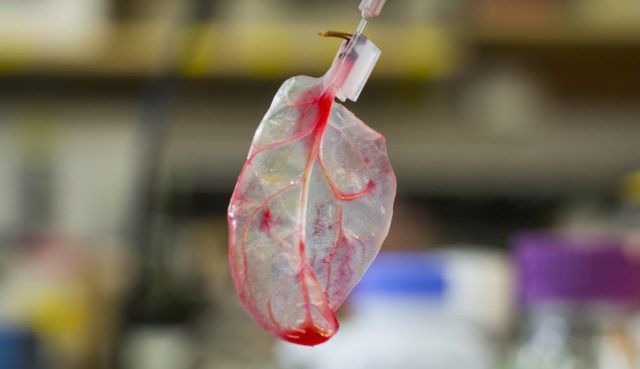Researchers at Worcester Polytechnic Institute have created artificial heart tissue with functioning vasculature by stripping a spinach leaf of its original cells and replacing them with human cells.
The spinach leaf was used to solve a problem faced by biological engineers when creating artificial tissues and organs. Methods such as 3D printing that generally make good copies do not have the ability to recreate the complicated vascular systems that are needed to ensure the success of any bioengineered tissue. If oxygen and nutrients cannot be transported to the cells, then that organ will fail and die.
While plants use their vasculature to transport water and nutrients rather than blood, the access to the cells that it provides is similar in design to animals. Combined with the fact that cellulose is compatible with human biology, the researchers saw a new opportunity to utilize plants in bioengineering.
The process was relatively simple. The spinach leaf was first bleached via a detergent pumped through the veins, stripping away the plant cells. This took several days to complete, after which human blood vessel cells were implanted to make the veins to be compatible with human biology. The process was finished off by covering the leaf in human heart cells, which attached themselves to the skeleton. Eventually, the cells started beating like an actual heart, allowing mock blood to flow through the system. Similar experiments were conducted with peanut plants and parsley.
Joshua Gershlak, a researcher at WPI in Massachusetts and the first author on the study explained in a press release where he got the inspiration from:
When I looked at the spinach leaf, its stem reminded me of an aorta. So I thought, let’s perfuse right through the stem. We weren’t sure it would work, but it turned out to be pretty easy and replicable. Its working in many other plants.
This is just one step on a long road to successfully utilizing this process in medical science. Researchers need to make sure that plant scaffolds like these would not be rejected, once inside a host, with a further plan to make the new creations stronger. Glenn Gaudette, a professor of biomedical engineering wondered if they could “stack decellularized leaves, can we create a large thickness more along the thickness of a human heart wall?” Another theory was perhaps broccoli or cauliflower could be made to replicate lung tissue.
Along with requiring further optimisation, it also is unclear how the tissues could be used to actually create a new organ. Researchers are upbeat, claiming that while further investigation may still be needed, “it has the potential to develop into a ‘green’ solution pertinent to a myriad of regenerative medicine applications.”
Jack Hadfield is a student at the University of Warwick and a regular contributor to Breitbart Tech. You can like his page on Facebook and follow him on Twitter @ToryBastard_ or on Gab @JH.

COMMENTS
Please let us know if you're having issues with commenting.